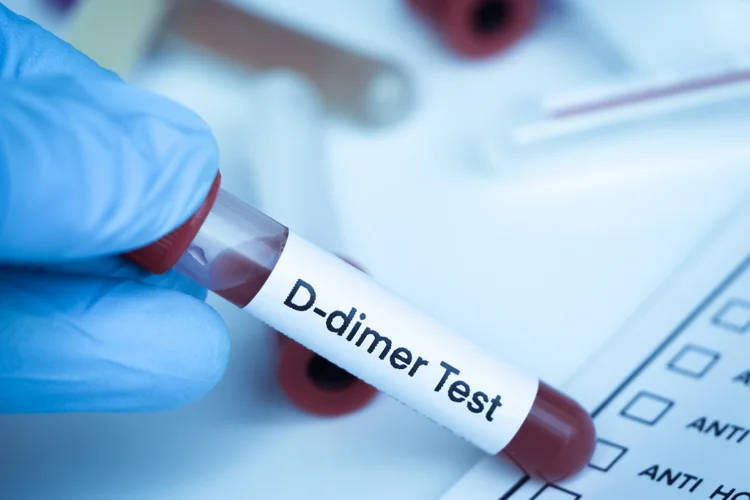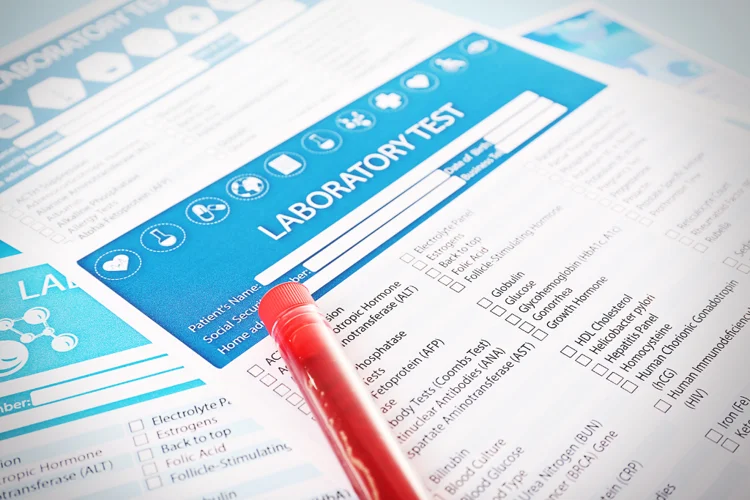D-Dimer Test
Last updated: Dec 20, 2025
What Is a D-Dimer Test?
The D-dimer test measures the level of D-dimer protein fragments in your
blood. These fragments are released when a blood clot breaks down.
In healthy individuals, D-dimer levels are typically very low. Elevated
levels may indicate that the body is forming and dissolving blood clots more frequently
than normal, which could suggest a blood clotting disorder or
other underlying conditions.
This test is commonly used to help rule out or detect conditions such as
deep vein thrombosis (DVT) and pulmonary embolism (PE).

How Does Blood Clotting Work?
Blood clotting is the body’s natural process to stop bleeding when a blood vessel is damaged. Platelets, which are tiny blood cells, quickly gather at the site of the injury to create a temporary seal or plug. Meanwhile, the body produces fibrin, a substance that acts like glue, holding the platelets together to form a stronger, more stable clot. Once the injury heals, the body breaks down the clot, releasing small fragments like D-dimer into the bloodstream.
Why Is a D-Dimer Test Performed?
A D-dimer test is used to detect abnormal blood clotting and is commonly performed to evaluate or rule out the following conditions:
| Condition | Common Causes | Symptoms & Complications |
|---|---|---|
| Deep Vein Thrombosis (DVT) | Prolonged immobility (e.g., travel, bed rest, after surgery), vein injury, cancer, or clotting disorders. |
Swelling, pain, warmth, redness, and tenderness in the leg. Can be asymptomatic.
Untreated clots may travel to the lungs, causing pulmonary embolism. |
| Pulmonary Embolism (PE) | Often caused by clots travelling to the lungs, frequently from DVT. Other risk factors include surgery, immobility, or cancer. |
Sudden shortness of breath, chest pain (worse with deep breathing), rapid heart rate,
and coughing (sometimes with blood).
Severe cases can cause low oxygen, lung damage, heart failure, or death. |
| Disseminated Intravascular Coagulation (DIC) | Triggered by severe infections (e.g., sepsis), trauma, cancer, or pregnancy complications (e.g., placental abruption). |
Bleeding (e.g., gums, surgical sites), bruising, and signs of clots (pain, swelling).
Can cause organ damage and life-threatening bleeding as substances needed to form clots deplete. |
How Is the Test Performed?
The D-dimer test is a simple procedure where a blood sample is drawn and sent to a laboratory to measure D-dimer levels. No special preparation is required.
Interpreting Test Results
D-dimer test results can be negative, positive, normal, low, or high. A negative result or normal levels usually rule out abnormal clotting activity, especially in low-risk cases. Low levels are typically not a concern and suggest no significant clotting issues. A positive result or high levels indicate increased clot formation and breakdown in the body. However, this test is not specific, meaning elevated levels can occur due to various reasons, such as pregnancy, surgery, infection, or cancer. Further tests, like an ultrasound or CT scan, may be recommended by your doctor to identify the exact cause.

D-Dimer Test Cost
At ATA Medical, we provide the D-dimer test and other blood tests at the following price:
| Test | Price* |
|---|---|
| Consultation | From $49.05 |
| D-dimer test | $150.42 |
| Full Blood Count | $17.44 |
| Full Blood Count (with ESR) | $26.16 |
We also offer personalized blood tests and health screening packages. These include options for home health screenings or blood tests at your chosen location to make the process more convenient. Please reach out to us for further details.
How Long Does a D-Dimer Test Take?
A blood test at our clinic usually lasts between 30-60 minutes during off-peak periods. Your results will be ready in 3-5 days and your doctor will inform you of the results via a phone call or email.
Where to Do a D-Dimer Test?
ATA Medical @ Orchard
Nearest MRT: Orchard Boulevard Station (TE13)
Contact Number: 6223 0682
Email: camden@atamed.sg
Opening Hours:
Mon - Fri: 8:30 AM to 12:30 PM, 1:30 PM to 5:30 PM
Sat: 8:30 AM to 12:30 PM
Sun & PH: Closed
ATA Medical @ Tanjong Pagar
Nearest MRT: Tanjong Pagar Station (EW15)
Contact Number: 6223 0682
Email: hi@atamed.sg
Opening Hours:
Mon - Fri: 8:30 AM to 12:30 PM, 1:30 PM to 5:30 PM
Sat: 8:30 AM to 12:30 PM
Sun & PH: Closed
ATA Medical @ Jurong
Nearest MRT: Jurong East MRT Station (NS1/EW24)
Contact Number: 6348 6292
Email: hi@atamed.sg
Opening Hours:
Mon - Fri: 8:30 AM to 12:30 PM, 1:30 PM to 5:30 PM
Sat: 8:30 AM to 12:30 PM
Sun & PH: Closed


